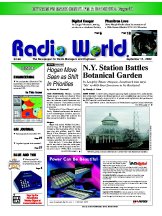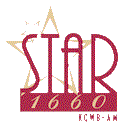
 |
|
|||||||||
|
|
 |
||||||||
 |
An
AM Expanded-Band
Success Story
in Fargo by Mark Persons |
Radio World Article September 11, 2002 |
 KQWB (AM) Radio in Fargo, ND., is one of the first AM station to completely switch from the traditional AM band to the expanded band. Actually they are licensed to West Fargo, but the transmitter is on the Minnesota side of the border. There
is quite a story to be told here.
Harsh
Conditions The station was deemed a significant interference contributor to the 1550 KHz frequency and was a prime candidate for the expanded band. It was granted a construction permit for 10 KW day and 1 KW night on 1660 KHz both, non-directional.
Because
adding a 1660 KHz station to the existing 5 tower antenna system would have
meant at least six RF filters and even more complication to the switching
system, the decision was made to completely turn off 1550 KHz in favor of the
1660 KHz expanded band frequency. A new Harris DX-10 Transmitter was ordered for 1660 KHz. It was installed and ready when I arrived in September of 2000. We turned off the 1550 KHz transmitter for the last time and got to work. A tower climber used a strap to permanently bond the top and bottom sections of the center tower to make it a five-eights wave radiator on 1660 KHz.
The
other four towers were disconnected and I measured the antenna resistance on the
new 1660 KHz frequency. After a few
calculations, we started moving components around in the center tower antenna
coupling network. This also
involved removing the antenna pattern switching relay.
A few trial and error moves tuned the antenna coupling network for
broadband performance.
Successful
Switch
The
new KQWB-AM 1660 KHz station was on the air by late in the afternoon with a
great sounding signal. It is
running in Motorola AM stereo and serves the Fargo/Moorhead market well day and
night. The 1550 KHz is gone forever from this site.
How how have things gone since the changeover? Mark Borchert reports that maintenance has been next to zero. The station now runs local sports involving cities that were in the night directional pattern nulls on the old frequency.
The
average market share for 35+ is almost exactly what it was prior to the change.
The format is nostalgia. Mark
reported having to spend some time with listeners getting them converted over to
the new frequency. That problem is
past now, now and the sailing appears to be clear for a station that had
been facing financial disaster from engineering expenses. Mark Persons, ham W0MH, is certified by the Society of Broadcast Engineers as a Professional Broadcast Engineer with more than 30 years experience. He has written numerous articles for Radio World over the years. His Web site is www.mwpersons.com From the Radio World
September 11, 2002 http://www.rwonline.com |
|
Questions? Email Mark Persons: teki@mwpersons.com |
|
.